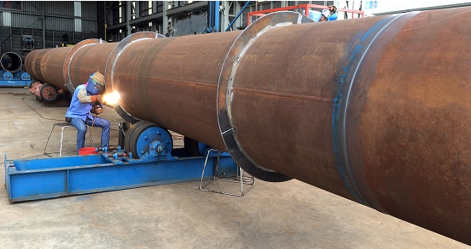This article explains Steel Fabrication in the Oil and Gas Industry, Steps and Roles of Steel Fabrication in the Oil and Gas Industry.
Introduction
Steel fabrication has played a critical role in the vast development of the oil and gas industry in the gulf nations just as water plays a crucial role in the existence of man. Oil and gas production is incomplete without steel fabrication because it provides reliable and robust structures to withstand the harsh environment of oil and gas production, transportation, and storage. The demand for steel fabrication in the oil and gas industry is expected to increase in the coming years due to the growing demand for oil and gas in the mid-east from other countries of the world. As the oil and gas reserves become more challenging to access, the need for complex structures and equipment will increase. Therefore, steel fabrication will continue to play a vital role in the oil and gas industry.
Read: HYDROCARBON GAS LIQUIDS/Definition/Types/Facts
What is steel fabrication in the oil and gas industry?
Steel fabrication is a highly specialized process that requires skilled professionals, advanced technology, and precise equipment. The fabrication process involves cutting steel into specific shapes and sizes, welding, machining, and finishing. The final product must meet the strict requirements of the oil and gas industry, including safety standards, quality control, and environmental regulations. It can also be done for various purposes, including building bridges, housing, factories, and other large structures.
Steps of steel fabrication.
The main steps involved in the process of steel fabrication includes the following:
- Design Preparation: The first step in any steel fabrication process is design preparation, it’s the blueprint where the drawings and specifications for the project are created and agreed.
- Material Acquisition: This involves ordering the steel from a supplier. Steel can be in standard length or already cut into length based on the order. The steel will then be delivered to the fabrication site.
- Steel Cutting and Drilling: Steel cutting can be performed by circular saw machines, laser cutting machines, waterjet machines, or plasma cutting machines. The steel is first cut to the correct length and then drilled to create the holes needed for the project.
- Bending and welding: Various bending processes such as section bending, roll bending, plate bending, and tube bending are performed to create the desired shape. The steel is then welded together using either MMA welding or MAG welding.
Read: OIL WELL
- Quality Check: The quality check ensures that the steel meets all the required specifications. It includes visual inspections, dimensional inspections, and mechanical tests. Non-destructive testing (NBT) is also performed to ensure that the welded parts are free from hidden defects and cracks.
- Finishing: Is the final touch that makes a product’s fabrication complete. Sometimes it includes painting, rust-proofing, or glazing. Brushing, shining, polishing, and adding decals are all a part of the finishing process.
- Delivery, Assembly, and Installation: In the final step, the steel is delivered to the site and assembled as per the required design. Assembling involves bringing all of the pieces together to form the final product. The assembly process usually involves bolting, riveting, or welding the steel parts together. The fabricated steel parts must be handled carefully to avoid any damage. Installation can be performed by using heavy-duty cranes.
Roles Of Steel Fabrication in The Oil and Gas Industry
Almost all equipment and machinery used in the oil firm are supplied by metal fabrication companies. In the oil sector, steel is used in a wide range of applications, from building offshore platforms and drilling rigs to constructing pipelines and storage tanks. Some of the key applications of steel fabrication in the oil and gas industry includes:
Equipment: equipment used in the oil and gas industry are made of structural steel. All kinds of critical parts are manufactured by structural steel fabricators. Pipelines, pressure vessels, and oil and gas separators are some of the applications of structural steel in the oil and gas industry. E.g:
- Pipelines
- Oil and Gas Separators.
- Drilling equipment eg drill bits, drill pipes, and casing
- Pipes and pipelines
- Storage tanks
Read: Pipeline Pigging Equipment in the Oil and Gas Sectors
Infrastructure: Infrastructure of the oil sector is very complex. An oil rig or an oil platform is a large structure with facilities to drill wells, extract and process oil and natural gas. Some of these oil platforms even have facilities to house workforce and they are built on steel legs. E.g:
- Offshore platform
- Oil rigs
- Structural supports
- Pressure Vessels
Without steel fabrication, production of oil and gas will not be possible which will in turn deny us as humans the luxury of life we all are enjoying through oil and gas. For instance, without steel fabrication pipelines won’t be available to carry oil and gas from drilling sites to the refineries which means there won’t be fuel for cars and aircraft’s etc.

